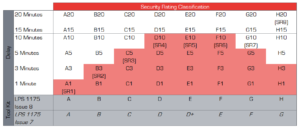Understanding LPS 1175 Issue 8
The most significant revision to date, Issue 8 has introduced several major changes for security standard LPS 1175. Developed and tested by industry experts, Issue 8 seeks to provide a more realistic view of attack scenarios.
LPS 1175 is primarily concerned with providing an effective physical solution to combat serious criminal activity. Within previous revision LPS 1175 Issue 7, the guidelines for specification left serious lapses in the physical defence of a property.
Issue 8 combines the most effective methods of specification from previous revisions with a more in-depth understanding of potential risk.
This latest revision moves away driving specification of a single security measure. Instead, Issue 8 defines effective resistance in support of a layered approach formed of multiple products. These products are evaluated according to the threat level and minimum delay in minutes.
Route to specification
LPS 1175 is a fantastic tool for specifying an appropriate security measure.
With backing from BRE (Building Research Establishment). there are over 70 LPS (Loss Prevention Standards) offered by LPCB (Loss Prevention Certification Board) concerning fire and security.
Each LPS focuses on a specific area of a property, from entry access to fire alarms. LPS 1175 Issue 8 concentrates on vital building components such as doors, shutters and walling.
Within this revision, the are four key changes that make a clearer route to specifying the best-suited product:
- Tool Categories
- Specific Tools
- Testing Scenarios
- Classification

1 Tools Categories
Within this revision, a preliminary change is to the categories of tools to account for the quantity used in an opportunistic vs experienced attack.
This change acknowledges the quantity and combined weight, against the total duration of an attack.
2 Specific Tools
This notes a direct change to the tool kits detailed in previous revisions.
Tools noted within LPS 1175 Issue 7 including portable powered and petrol driven tools have been reevaluated. Along with masonry type carbide tipped drill bits, both tools have been established in high tool kit category.
3 Testing Scenarios
Previous revisions have highlighted how these heavily-regulated testing scenarios are made to be redundant in real-life scenarios.
Within Issue 8, it goes a step further. This revision acknowledges firstly that a specification of a single product cannot assume to be 100% effective.
Secondly, it recognises that a product tested by a single attacker will not perform the same in a real incident if there are multiple attackers.
4 Classification
Combining this reevaluated threat level (tools plus attackers), BRE has recognised that a strategic delay is better compromised of multiple layers of physical defence.
By implementing multiple products of different lower ratings, specifiers and architects alike can achieve a higher classification.
Understanding the ratings
BRE describes LPS 1175 Issue 8 as:
“Formed of two elements that illustrate performance in terms of:
- Threat level (first element) – Letter (A to H) corresponding with the tool kit used to evaluate the product’s intruder resistance and the number of attackers involved.
- Delay (second element) – Numeric value (1, 3, 5, 10, 15 or 20) corresponding with the minimum delay (in minutes) provided by the product when placed in a locked condition.”
A property can, therefore, achieve a higher overall rating by combining multiple appropriate products.
A primary benefit here is that properties can avoid implementing a security measure that is over-engineered for the threat faced.
Visit RedBook Live to view our certifications LPS 1175 here.



